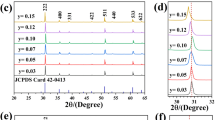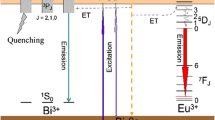Abstract
for healthy lighting, daily lighting that considers both visible light and near-infrared (NIR) light is necessary. However, at ∼900 nm, the extensively used solar-like phosphor-converted light-emitting diodes (pc-LEDs) are limited by a lack of high-performance NIR luminescent materials. We report a broadband NIR phosphor Sr2ScSbO6:Cr3+ with a double perovskite-type structure, thus simultaneously demonstrating high luminescence efficiency and good thermal stability. Under 550-nm excitation, Sr2ScSbO6:Cr3+ demonstrates broadband NIR emission centered at ∼890nm with luminescence internal/external efficiencies of 82.0%/35.7%, respectively. Furthermore, the luminescence integrated intensity at 430 K remains at ∼66.4% of the initial intensity. We successfully fabricated pc-LED devices using a 465-nm-sized blue chip and other commercial phosphors, presenting a relatively complete solar-like spectrum from blue to NIR light and is expected to be used in solar-like lighting.

摘要
类太阳光光源包含可见光和近红外(NIR)光, 在健康照明等领域 具有重要的应用. 然而众多应用却由于目前缺乏具有高效率和高发光 热稳定的900 nm附近的NIR发光材料而受到限制. 在此, 我们报道了一 种具有双钙钛矿型结构的宽带NIR荧光粉Sr2ScSbO6:Cr3+, 其具有高发 光效率和良好的发光热稳定性. 在550 nm光激发下, 该材料具有以 ~890 nm为中心的宽带NIR发射, 发光内/外量子效率分别为82.0%/35.7%. 此外, 材料显示出优良的发光热稳定性, 在430 K下的发光积分 强度保持初始强度的66.4%. 结合465 nm蓝光芯片和其他商用荧光粉, 我们成功制作了荧光粉转换发光二极管器件, 呈现出从蓝色到近红外 光的相对完整的类太阳光谱, 有望用于日常照明和类太阳光谱发光器 件.
Similar content being viewed by others
References
Holick MF. Sunlight and vitamin D for bone health and prevention of autoimmune diseases, cancers, and cardiovascular disease. Am J Clin Nutr, 2004, 80: 1678S–1688S
Liao SK, Yong HL, Liu C, et al. Long-distance free-space quantum key distribution in daylight towards inter-satellite communication. Nat Photon, 2017, 11: 509–513
Guo L, Yan DD, Yang D, et al. Combinatorial photothermal and immuno cancer therapy using chitosan-coated hollow copper sulfide nanoparticles. ACS Nano, 2014, 8: 5670–5681
Zhang L, Wang D, Hao Z, et al. Cr3+-doped broadband NIR garnet phosphor with enhanced luminescence and its application in NIR spectroscopy. Adv Opt Mater, 2019, 7: 1900185
Guelpa A, Marini F, du Plessis A, et al. Verification of authenticity and fraud detection in South African honey using NIR spectroscopy. Food Control, 2017, 73: 1388–1396
De Beer T, Burggraeve A, Fonteyne M, et al. Near infrared and Raman spectroscopy for the in-process monitoring of pharmaceutical production processes. Int J Pharm, 2011, 417: 32–47
Fang MH, Li TY, Huang WT, et al. Surface-protected high-efficiency nanophosphors via space-limited ship-in-a-bottle synthesis for broadband near-infrared mini-light-emitting diodes. ACS Energy Lett, 2021, 6: 659–664
Arvesen J, Benning FN, Castle JA, et al. Handbook of Solar Simulation for Thermal Vacuum Testing. Mount Prospect: Institute of Environmental Sciences, 1968
Petrasch J, Coray P, Meier A, et al. A novel 50kW 11,000 suns high-flux solar simulator based on an array of xenon arc lamps. J Sol Energy Eng, 2007, 129: 405–411
Kuhn P, Hunt A. A new solar simulator to study high temperature solid-state reactions with highly concentrated radiation. Sol Energy Mater, 1991, 24: 742–750
Ulmer S, Reinalter W, Heller P, et al. Beam characterization and improvement with a flux mapping system for dish concentrators. J Sol Energy Eng, 2002, 124: 182–188
Zhao F, Cai H, Song Z, et al. Structural confinement for Cr3+ activators toward efficient near-infrared phosphors with suppressed concentration quenching. Chem Mater, 2021, 33: 3621–3630
Martín-Rodríguez R, Valiente R, Rodríguez F, et al. Temperature and pressure dependence of the optical properties of Cr3+-doped Gd3Ga5O12 nanoparticles. Nanotechnology, 2011, 22: 265707
Zhang L, Zhang S, Hao Z, et al. A high efficiency broad-band near-infrared Ca2LuZr2Al3O12:Cr3+ garnet phosphor for blue LED chips. J Mater Chem C, 2018, 6: 4967–4976
Hayashi D, van Dongen AM, Boerekamp J, et al. A broadband LED source in visible to short-wave-infrared wavelengths for spectral tumor diagnostics. Appl Phys Lett, 2017, 110: 233701
Cai H, Liu S, Song Z, et al. Tuning luminescence from NIR-I to NIR-II in Cr3+-doped olivine phosphors for nondestructive analysis. J Mater Chem C, 2021, 9: 5469–5477
Liu T, Cai H, Mao N, et al. Efficient near-infrared pyroxene phosphor LiInGe2O6:Cr3+ for NIR spectroscopy application. J Am Ceram Soc, 2021, 104: 4577–4584
Zhou X, Geng W, Li J, et al. An ultraviolet-visible and near-infrared-responded broadband NIR phosphor and its NIR spectroscopy application. Adv Opt Mater, 2020, 8: 1902003
Xu X, Shao Q, Yao L, et al. Highly efficient and thermally stable Cr3+-activated silicate phosphors for broadband near-infrared LED applications. Chem Eng J, 2020, 383: 123108
Basore ET, Xiao W, Liu X, et al. Broadband near-infrared garnet phosphors with near-unity internal quantum efficiency. Adv Opt Mater, 2020, 8: 2000296
Mao M, Zhou T, Zeng H, et al. Broadband near-infrared (NIR) emission realized by the crystal-field engineering of Y3−xCaxAl5−xSixO12:Cr3+ (x = 0–2.0) garnet phosphors. J Mater Chem C, 2020, 8: 1981–1988
Zeng H, Zhou T, Wang L, et al. Two-site occupation for exploring ultra-broadband near-infrared phosphor—Double-perovskite La2MgZrO6:Cr3+. Chem Mater, 2019, 31: 5245–5253
Zhao F, Song Z, Zhao J, et al. Double perovskite Cs2AgInCl6:Cr3+: Broadband and near-infrared luminescent materials. Inorg Chem Front, 2019, 6: 3621–3628
Liu S, Wang Z, Cai H, et al. Highly efficient near-infrared phosphor LaMgGa11O19:Cr3+. Inorg Chem Front, 2020, 7: 1467–1473
Rodríquez-Carvajal J, Roisnel T. Line broadening analysis using Full-Prof*: Determination of microstructural properties. Mater Sci Forum, 2004, 443–444: 123–126
Patterson FK, Moeller CW, Ward R. Magnetic oxides of molybdenum(V) and tungsten(V) with the ordered perovskite structure. Inorg Chem, 1963, 2: 196–198
Song Z, Zhao J, Liu Q. Luminescent perovskites: Recent advances in theory and experiments. Inorg Chem Front, 2019, 6: 2969–3011
Ray R, Himanshu AK, Bandyopadhyay SK, et al. Ab-initio study of structural phase transitions, electronic and optical properties of the double perovskite A2ScSbO6 (A = Sr, Ca). Physics, 2013, 13: 104853
Zhou J, Rong X, Zhang P, et al. Manipulation of Bi3+/In3+ transmutation and Mn2+-doping effect on the structure and optical properties of double perovskite Cs2NaBi1−xInxCl6. Adv Opt Mater, 2019, 7: 1801435
Tanabe Y, Sugano S. On the absorption spectra of complex ions II. J Phys Soc Jpn, 1954, 9: 766–779
Casalboni M, Luci A, Grassano UM, et al. Optical spectroscopy of La3Ga5SiO14:Cr3+ crystals. Phys Rev B, 1994, 49: 3781–3790
Henderson B, Imbusch GF. Optical Spectroscopy of Inorganic Solids. New York: Oxford University Press, 1989
Huang CH, Chen TM, Liu WR, et al. A single-phased emission-tunable phosphor Ca9Y(PO4)7:Eu2+,Mn2+ with efficient energy transfer for white-light-emitting diodes. ACS Appl Mater Interfaces, 2010, 2: 259–264
Murakami S, Herren M, Rau D, et al. Photoluminescence and decay profiles of undoped and Fe3+, Eu3+-doped PLZT ceramics at low temperatures down to 10 K. Inorg Chim Acta, 2000, 300–302: 1014–1021
Yao L, Shao Q, Han S, et al. Enhancing near-infrared photoluminescence intensity and spectral properties in Yb3+ codoped LiScP2O7:Cr3+. Chem Mater, 2020, 32: 2430–2439
Gao T, Zhuang W, Liu R, et al. Design of a broadband NIR phosphor for security-monitoring LEDs: Tunable photoluminescence properties and enhanced thermal stability. Cryst Growth Des, 2020, 20: 3851–3860
Acknowledgements
This work was supported by the National Natural Science Foundation of China (51972020 and 51832005). We thank Dr. Tianliang Zhou from Xiamen University for IQE/EQE measurements.
Author information
Authors and Affiliations
Contributions
Liu Q and Zhao M conceived the idea; Liu Q supervised the project; Zhao M carried out materials synthesis, device fabrication, and most of the measurements. Cai H and Zhao F participated in part of the experiments; Zhao M analyzed the data and charted the figures and table. Liu Q, Song Z, and Liu S revised the paper. All authors discussed the results and revised the manuscript.
Corresponding authors
Additional information
Conflict of interest
The authors declare that they have no conflict of interest.
Supplementary information
Supporting data are available in the online version of the paper.
Meng Zhao is currently a PhD candidate in materials science and engineering under the supervision of Prof. Quanlin Liu at the University of Science and Technology Beijing (USTB). His research focuses on Cr-doped perovskite-type oxide luminescent materials.
Quanlin Liu completed his PhD degree in condensed matter physics in 1998 at the Institute of Physics, Chinese Academy of Sciences (IOP CAS). From 1998 to 2005, he worked as an assistant and associate professor at IOP CAS, including working as a Japan Society for the Promotion (JSPS) fellow at the National Institute for Materials Science, Japan (2001–2003). Since 2005, he has been a full professor in materials science at the USTB. His current research interests primarily focus on luminescent materials.
Zhen Song received his PhD degree from the School of Materials Science and Engineering, USTB, in 2014. He is currently an associate professor at the Department of Materials Science and Engineering, USTB. His research interests focus on solid-state luminescence theory and rare-earth-doped luminescent materials.
Supporting Information
Rights and permissions
About this article
Cite this article
Zhao, M., Liu, S., Cai, H. et al. Efficient broadband near-infrared phosphor Sr2ScSbO6:Cr3+ for solar-like lighting. Sci. China Mater. 65, 748–756 (2022). https://doi.org/10.1007/s40843-021-1785-6
Received:
Accepted:
Published:
Issue Date:
DOI: https://doi.org/10.1007/s40843-021-1785-6




